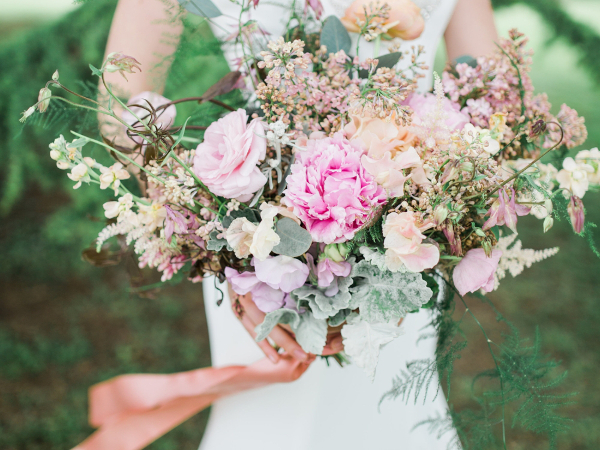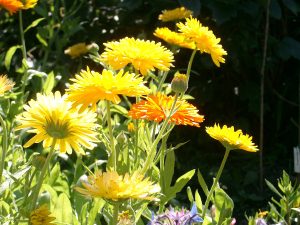You don’t want to show someone you love them by damaging the environment, do you? It sounds unromantic, but it’s really difficult to buy flowers in the UK that aren’t sprayed with huge amounts of pesticides, doused with chemical preservatives and flown half way across the world. But there’s an alternative. We interview Rachel of Catkin English Country Flowers to find out what it is.

Lowimpact: So where do most flowers you can buy in the UK come from?
Rachel: 80% of flowers sold in the UK are imported from various parts of the world, and the majority come through Dutch auctions. Most flowers in the world come from Kenya, Ecuador, Colombia and the Netherlands (where they’re grown in glasshouses and polytunnels). Kenya provides around 25% of the cut flowers sold in the EU, and about 30% of the flowers grown in Kenya end up in the UK.
LI: Why are flowers so important to the Dutch economy?
RP: Since the 80s and 90s, the Dutch flower trade has dominated due to the huge state subsidies provided for gas and electricity for their enormous heated greenhouses. In the 50s, the Dutch government invested massively in horticulture and flower-growing – including subsidies for research and technology. They began to totally dominate the flower industry. But since the crash of 2008, rising costs and falling subsidies have meant that they’re starting to struggle.

LI: Isn’t it better to get flowers from the Netherlands than from other continents?
RP: Well, flowers from Kenya and Latin America are flown, so they have a big carbon footprint, but actually, there are studies (including this one by Cranfield University) that calculate that roses grown in the Netherlands have a five times greater carbon footprint than those grown in Kenya, because of the need for huge areas of glass – often heated. In Kenya, of course, you don’t need glasshouses or heated anything. However, whether from the Netherlands or Kenya, the eco-footprint of imported flowers is huge. It’s a very damaging industry.
LI: What about water use?
RP: Flowers need tons of water. It takes 7-13 litres of water to bring one rose flower to blossom. That’s one flower! In Kenya, studies have shown that the flower industry has devastated large water bodies like Lake Naivasha, where water levels have declined and pesticide runoff has decimated biodiversity.

LI: Does buying FairTrade make any difference?
RP: This is a tricky one. FairTrade means that there should be decent wages for flower growers, plus trade unions, no child labour etc. FairTrade flowers are better than non-FairTrade in that respect. There have been arguments between FairTrade groups and Flowers from the Farm, who promote UK-grown flowers. The position of the FairTrade groups was that at least people in the UK can feed their families, so it’s better to spend your money on FairTrade products, even if that means importing things that could be produced at home. I’d also argue that UK flowers producers also need to feed their families and flower production in this country is just as vital to peoples livelihoods.
LI: How much of the market for cut flowers is supplied by UK growers?
RP: About 20%. I think that this could increase quite a lot, but the UK can never satisfy all the demand for flowers, without huge areas of heated glasshouses. We could maybe get close to 50%, but we’ll probably never get over that unless demand falls. As the pound is falling, it makes it more expensive to import flowers (or anything), which is good for UK growers. UK flowers are now becoming cheaper.

LI: What are the barriers and what can we do about them?
RP: There’s a flower-buying platform called Florismart, where florists can go to get flowers from UK suppliers. You can get flowers from overseas too, but at least you can specify UK grower if you want to promote local production. FloraBritain is on the Florismart platrorm, and involves small UK growers getting together to sell under one label. It is also worth saying that there are brilliant wholesalers in Cornwall such as Flowers by Clowance, BJ Richards and Tregothnan who are growers themselves and also buy from local growers to sell wholesale. And UK-grown flowers are becoming noticeably cheaper compared to the competition from overseas. So things are happening. The problem is that there is a perception among a lot of florists that UK-grown flowers are not really good quality. This is wrong, but they’re going to need persuading. Florismart are doing a lot of work in that respect. They predict that most UK florists are going to get it soon, and there will be a switch from Dutch to UK flowers in the next few years.

LI: How many UK growers are there, and how can we support them?
RP: There are still nowhere near enough, but Lincolnshire and Cornwall are leading the way. But 77% of UK cut flowers are sold through supermarkets, and I’m sure you know this scenario with food production, but supermarkets sell flowers almost at cost, which puts independent florists out of business and makes life very difficult for growers. The most important thing you can do is buy from an independent florist not a supermarket or huge chain. Since I started in 2002, the number of small growers has increased. A group of around 300 ‘artisan growers’ have got together to try to punch above their weight. They’re all small producers, sometimes via gardens or allotments, and a lot of them are organic. They don’t use pesticides, but inability to source organic seeds sometimes means that they can’t all be called organic. They advertise themselves through Flowers from the Farm. They also meet regularly, and support each other via advice and bulk buying etc. The biggest advantage of the artisan group is that they don’t have to sell through a third party – they grow and sell direct to the consumer, via farm/garden gate sales, farm shops and mail order. They don’t have a central sales site, but if you to to Flowers from the Farm, they have a map on the site and you can call growers to see where you can buy their flowers, including from local florists.

LI: Any other benefits of using small UK growers?
RP: I’m a florist and I grow my own flowers for sale, and if I need more, I get them from other artisan growers. The natural diversity of artisan plots is huge. Unlike the large growers, we tend to grow a large range of plants, including shrubs, trees and herbs; plus we don’t use pesticides. We have lots of wildlife, we enrich the countryside and we provide a lot more jobs than the big growers. Imported flowers tend to be treated with over 20 different herbicides / fungicides while they’re growing, and they’re sprayed with more preservatives when shipped. In South America, 60% of flower workers have health issues related to exposure to pesticides that are often illegal elsewhere.

LI: Is it possible to get UK-grown flowers in winter?
RP: You can get some, but your choice is limited. The best are from Cornwall, and especially the Isles of Scilly, where there are small family farms that have been passed down from generation to generation, producing scented narcissi (daffodils) from October to March. However, February is a crazy month to have a ‘lovers’ day, where huge numbers of flowers are bought – because flowers are not in season in the UK! And if you get married in the UK in winter, I’d encourage you not to have red roses, because they’re bound to be very environmentally damaging. Have Cornish grown anemones or ranunculus instead.
LI: The future?
RP: There’s a huge PR exercise to be done on the perception of UK-grown flowers. We need to inform and educate the public and florists on their non-toxic nature and their benefits to communities and to biodiversity. We have a rich horticultural heritage in the UK. Let’s not lose it.







4 Comments
Dear Rachel,
Thank you for this.
Are you able to advise/comment on the reasons why modern shop-bought flowers don’t have a scent, whereas the same varieties grown “naturally” do? I don’t mean of course that they are chosen to look nice and sell rather than be appreciated for their other sensory qualities. Daffodils and roses are two particular examples, as in the shops they have no scent. It seems to be that if you want to buy flowers with a scent it is either impossible or the only option is fresias.
Is this something to do with how they are grown in sterile conditions, how they are treated, or (if having to cover lots of air miles) is it because they are picked when they are immature?
Andrew
Hi Andrew – I think it is to do with plant breeding. The varieties grown for commercial cut flower production have been bred to have good long stems, easy to pack and transport, good vase life and with a wide range of colour. Where certain characteristics are bred into a plant it is often at the expense of something else and that is often scent. My understanding is that scent reduces the vase life of a flower which is an issue if it has to be cut, packed, flown, auctioned and then sold to the consumer. Where flowers can be cut straight from the garden and as long as they are conditioned properly then the vase life is less affected as the journey from growing to vase is a short one. Does that make sense? Rachel
Thank you Rachel. Yes, your reply makes sense in that your explanation is probably correct. But, a does a world that can produce flowers bred for commercial reasons without scent make sense? No, it doesn’t!
Andrew
Ha ha – exactly!